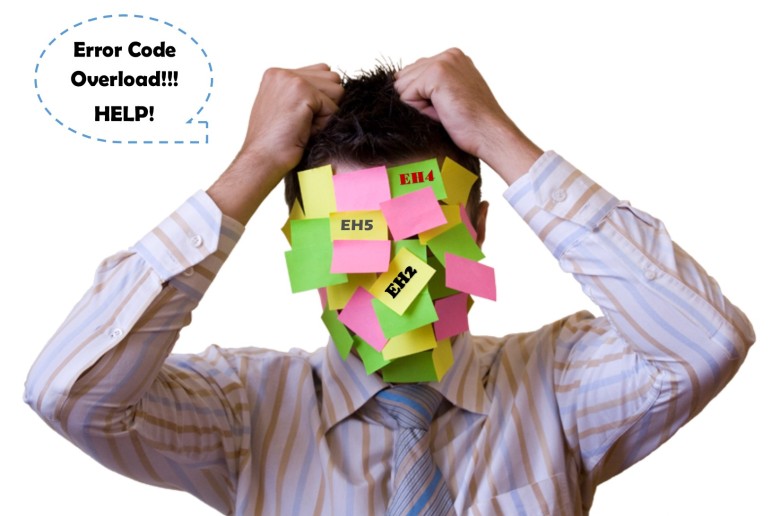
It’s a few days after you’ve submitted a big batch of claims to the Ministry of Health, you check your MCEDT account, and there they are: Error reports. You groan and hit print. It’s time for your favorite part of billing – clean up and resubmission.
We’ve all been there, and know that the claims sent back from the MOHLTC on error reports are our best friends – it’s easy to correct and resubmit the claims, which can get paid in the same monthly cycle if we’re quick about it – yet always take up more time than we have! We’re going to describe some of the more common error codes, and offer some helpful tips on resolving them quickly and easily. Well… easily at least.
EH2 – Invalid version code
This is certainly the most common error code. It means the OHIP card has expired and been renewed with a new 2 letter version code after the 10 digit OHIP number. Once in a while the version code will be 1 letter – eg/ Q, so if you see this you can submit. However, version codes never contain the letters “I” or “O”.
EH2 Solution
Fixing the problem is easy. If you’re on-site at the clinic or hospital, you can use your EMR-MOH connection or contact the patient to obtain the new version code. Of course, there’s also the Health Information Custodian (HIC) programme, which allows physicians and their agents to access OHIP numbers and version codes by calling in and providing the doctor’s PIN and some patient & claim information. Physicians must register for HIC and include the name(s) of any agents in order to receive a PIN number and be able to use this free service.
EH1 – Date of service is before OHIP coverage start date
For patients new to Ontario, there’s a wait time of three months before OHIP coverage becomes effective. If they were seen by a physician before that period is up, the claim isn’t payable through OHIP.
EH1 Solution
You can check if the patient came from another province – if so, their health insurance from that province will cover claims for the 3 month wait period. Alternately, ask about third party insurance coverage for out of country patients, and if all else fails physicians can bill patients directly for their services.
EH4 – Date of service is after OHIP coverage end date
This error code indicates that coverage has been terminated for any of a number of reasons – lost card, expired OHIP coverage, the MOH requires new information from the patient, etc. These codes generally require longer follow up as it can take a few months for OHIP coverage to be reinstated and backdated. EH4 is also sometimes used for deceased patients (see EH6).
EH4 Solution
The solution here is persistence. Contacting the patient to request that they update their OHIP card is first and foremost. In nearly all cases the MOH wants the OHIP card holder to contact Service Ontario in person or by phone. In other words, there’s nothing we can do from our end, resolving EH4’s requires the patient’s cooperation. For deceased patients, it’s worth a try to have the patient’s family contact Service Ontario to update coverage – this generally depends on how long it’s been since the patient had valid OHIP coverage.
When we get EH4’s back at JCL, we follow these claims right up to the day the claim becomes stale, and in nearly all cases persistence gets the claim paid.
EH5 – Date of service isn’t within eligible period
The definition of EH5 is rather vague, but in our 30 years of experience the code almost always refers to patients who don’t yet have OHIP coverage. So in effect, the code behaves much like EH1 in that coverage can’t be backdated, and non-OHIP billing options are the next course of action.
EH6 – Patient deceased
This code indicates that the claim was billed to a deceased patient. If coverage lapsed some time before the patient passed away, EH4 may be returned as well.
EH6 Solution
If you get EH6, check that your service date was billed correctly – if it’s after the date of death, the claim will not be paid. For claims before that date, in some cases coverage can be backdated and reinstated by the next of kin, who would have to get in touch with Service Ontario.
The EH series error codes deal with OHIP coverage eligibility, and are only the tip of the iceberg. We’ll post additional blogs on other error codes, including referring physician errors, patient demographic errors, diagnostic code errors, maximums reached, problems with speciality, diagnosis, and SLI indicators to name a few. If you have any specific questions, don’t hesitate to get in touch, and if you want your answer posted, try out our Request a Blog.
More on Error Codes: the VH8 Flood of 2014
Error Codes: Problems with referral billing numbers
Here’s hoping your error reports are short, few, and far between!
